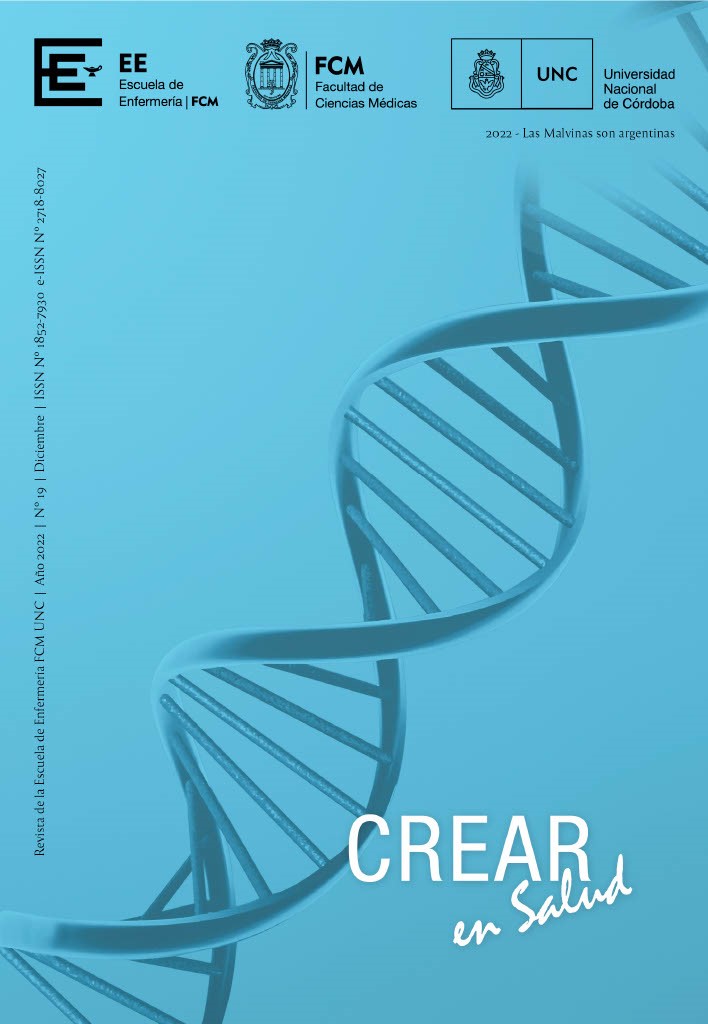Perception of risks in the operating theater
Keywords:
Perceptions. Risks. Surgical cares.Abstract
Introduction: The operating theater is the area where the anesthetic-surgical procedures, whether elective or urgent, are carried out. This area is characterized by complex and interdisciplinary practices. Biosecurity in the operating theater has always been an important issue for the health of the population in general. The healthcare staff’s perception about the risks in the operating theater is an issue of constant concern in the health sector. Perception can be found as an antecedent in the mental construction of every worldview. The perception of risks is related to the approach that was used to explain the process of comprehension and analysis of the causeeffect relations. Objective: To determine the perception of the risks to which instrument nurses are exposed to in the surgery sector at the La Familia I Clinic in the city of Córdoba in July 2021. Methodology: A quantitative, descriptive, cross-sectional work was carried out at the La Familia I Clinic in July 2021. The population consisted of 20 instrument nurses. No sample was established. A primary source was used and the interview was the technique chosen. A self-administered questionnaire was used, which included open-ended and closed-ended questions that provided answers to the studied variable. Results: Among the interviewees, the female gender prevailed with a score of
14/20 and an age range of 30/39 years old.The staff perceives the risk in their daily tasks and, in order of importance, the prevailing risks were those arising from contagions, health alterations, human mistakes due to tiredness, radiation and physical factors. Regarding the perception of physical risks, the prevailing ones are those arising from liquid splashes, cutting
and puncturing while manipulating or disposing sharp elements, disease contagions, ionizing radiation (RTx) and non-ionizing radiation (laser), infrared, ultraviolet, compressed gasses and fires. Regarding the perception of chemical risks, the highlighted risks are human surgical gasses, formaldehydes, disinfectants, anesthetics, antiseptics that may all cause skin or eye injuries or may increase the probability of cancer disease. The answers show a clear perception of the biological risk of suffering cuttings, puncturings and of acquiring transmittable diseases. Conclusion: The staff perceives being exposed not only to physical risks, chemical and biological, but also to those risks inherent to the job’s standards, responsibilities, organization and division of labor.
References
Arenas Monsalve, G. (2010). Los riesgos de trabajo y la salud ocupacional en Colombia. Segunda edición. Universidades Nacional, Javeriana y de los Andes. Colombia: Legis Fondo editorial.
Bestratén, M, y Nogareda, C. (2002). Evaluación de las condiciones de trabajo en pequeñas y medianas empresas. España: Editorial Instituto Nacional de Seguridad e Higiene en el trabajo. MTAS- ISBN: 9788474255690
Chacón-Quesada, T. et al. (2009). ITS Y SIDA en adolescentes: descripción, prevención y marco legal. Revisión bibliográfica. Med. leg. Costa Rica vol.26 n.2 Heredia sep. 2009. On-line versión ISSN 2215-5287. https://www.scielo.sa.cr/scielo.phpscript=sci_arttext&pid=S1409-00152009000200008
Gibson, J. (1990). La perspectiva ecológica de Gibson. Citado en: Revista Digital Psicología Ambiental en (2021). Universidad de Barcelona. España. http://www.ub.edu/psicologia_ambiental/unidad-2-tema-2-3-4#:~:text=Para%20Gibson%2C%20toda%20la%20informaci%C3%B3n,tan%20s%C3%B3lo%20un%20significado%20proyectado
Ivancevich, J. M. (2012). La seguridad en el empleo. La ambigüedad sobre el futuro del empleo. En: Factores psicosociales y de organización. Enciclopedia de Salud y Seguridad en el Trabajo. 34.34-Chile. http://alumnos.ipchile.cl/biblioteca_web/ENCICLOPEDIA%20DE%20SALUD%20Y%20SEGURIDAD%20EN%20EL%20TRABAJO%20(OIT)/Vol.II_parte%20V_%20Factores%20Psicosociales%20y%20de%20Organizaci%C3%B3n/Cap.34_ Factores%20Psicosociales%20y%20de%20Organizaci%C3%B3n.pdf
Ministerio de Trabajo, Empleo y Seguridad Social. (2021). Riesgos de trabajo. En Argentina.gov.ar. Ciudad Autónoma de Buenos Aires. https://www.argentina.gob.ar/trabajo/buscastrabajo/conocetusderechos/riesgos-de-trabajo
Oviedo, G. L. (2004). La definición del concepto de percepción en psicología con base en la teoría Gestalt. Revista de Estudios Sociales, núm. 18, agosto, 2004, pp. 89-96. Universidad de Los Andes. Bogotá, Colombia. https://www.redalyc.org/articulo.oa?id=81501809
Restrepo R., Pérez, P. y Escobar, M. L. (2009). Evolución del sistema general de riesgos profesionales, Colombia 1994 –2004. Revista de la Facultad Nacional de Salud Pública 2009; 27(2): 226-238. http://www.scielo.org.co/pdf/rfnsp/v27n2/v27n2a14.pdf
Solórzano Álvarez, E. y Rodríguez Quesada, L. (2019). Evaluación del riesgo biológico en el área quirúrgica de una instalación de salud. Revista Cubana de Cirugía. vol.58 N°4. Ciudad de la Habana. Versión On-line ISSN 1561-2945. http://scielo.sld.cu/scielo.php?script=sci_arttext&pid=S0034-74932019000400001
Triviño Mosquera, M., Bembibre Serrano, J. y Arnedo Montoro, M. (2019). Neuropsicología de la percepción. Serie Neuropsicología de los procesos cognitivos y psicológicos. ISBN: 978-84-9171-263-3. España. https://www.sintesis.com/data/indices/9788491712633.pdf
Villalobos Fajardo, G. H. (2009). Identificación y Evaluación de los factores de riesgo Psicosocial. Vol. 32. Congreso de Seguridad Integral, Higiene y Medicina del Trabajo Consejo Colombiano de Seguridad. Colombia.
Zubiri, M. O. (2012). Riesgos derivados del trabajo en quirófano. Encuesta de evaluación de riesgos laborales al personal sanitario. Universidad de Medicina Preventiva y Salud Pública del Departamento de Ciencias de la Salud de la Universidad Pública de Navarra. España. http://academica-e.unavarra.es/bitstream/handle/2454/6323/TFM_%20MARIA%20OSES%20ZUBIRI%20(Unificado).pdf?sequence=1
Downloads
Published
Issue
Section
License
Copyright (c) 2022 Crear en Salud

This work is licensed under a Creative Commons Attribution-NonCommercial 4.0 International License.



